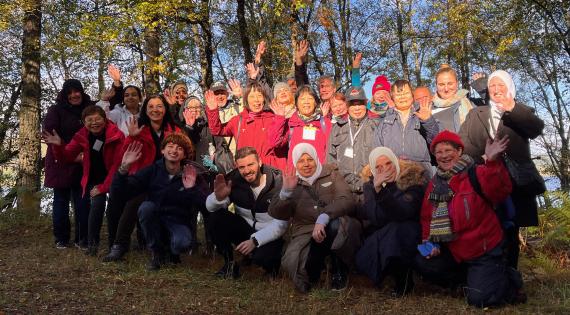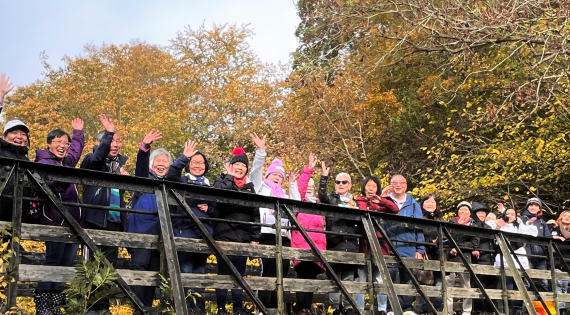During Autumn 2022 we invited community groups through ELREC to attend forest walks. The walks were guided by artist, Tamsin Grainger and UKCEH researcher, Juan Pablo Lobo-Guerrero Villegas. We walked through forest paths and did activities aimed at giving people a chance to engage in sensory experiences of the forest, think about values associated to forest environments, and have a relaxed and enjoyable time.
Forest walks

Black Wood of Rannoch group

Roslin Glen group
Black Wood of Rannoch
The Black Wood of Rannoch is one of 21 ancient Caledonian pinewoods in Scotland of genetic conservation significance. These forests are dominated by mature Scots pines (Pinus sylvestris), many of them hundreds of years old. Fewer younger trees make for an uneven population structure, likely due to centuries of grazing and burning inhibiting regeneration.
Participants from Chinese, Polish and Syrian communities joined us for an autumn walk along the forest path and activities including measuring the girth of the largest trees, drawing interpretations of forest landscapes and sharing knowledge of mushrooms.
Walking along the forest path at Black Wood of Rannoch
Gathered at Gunnar's Tree, named after Gunnar Godwin who inspired the designation of the area as a forest reserve
Members of the Polish community shared their knowledge of mushrooms with the group
Drawing forests based on memories of childhood home
Discovering details in the shape, colour and texture of the forest
Measuring the diameter of trees and using the rope to make quipus, an ancient method to record information by tying knots in rope used in Inca culture
Members of the group shared foraging knowledge, including berries and mushrooms
Identifying mushrooms based on morphological traits
Walking among the 'granny trees'
Roslin Glen
Within reachable distance of Edinburgh using public transport, Roslin Glen represented a counter-balance to the Black Wood, highlighting that forests do not just occur in remote places, but are also in close proximity.
Participants from Chinese and Polish communities joined us for walks along the different paths, bark rubbings, photography and storytelling sessions.
Doing bark rubbings to capture the texture of different tree species
'Meet a tree' game: meeting a tree blindfolded to engage with its smell, texture, shape and size, and then trying to find the same tree after removing blindfolds
Singing Polish songs
Measuring the girth of the largest tree we found required the efforts of more than one person
Looking at leaf morphology to identify tree species and talking about diseases visible in foliage
Sharing stories and folk tales of forests
Taking photos along the walk
Tree silhouette captured by participant walking along Roslin Glen
Detail of leaves and fruit (photo taken by participant)
Twin trunks (photo taken by participant)
River North Esk (photo taken by participant)
Birch forest (photo taken by participant)
Talking about visiting different forests in and around Edinburgh
Art workshop: revisiting the autumn forest
We revisited the forest walks through a workshop session at McDonald Road Library. Members of ELREC community groups were again invited to take part. The aim was to explore the shapes, colours, textures and details of the autumn forest through a series of visual arts media including collages, painting and drawing. Much of the material produced during this session will be curated and featured at the community group art exhibition. This was also a space to bring the sensory memories of the forest inside, including smells (essential oils) and textures (pressed leaves).
Cooperation and kinship surfaced as a key elements in conversations about forest conservation needs. This mirrored cooperative behaviour during the forest walks where members of different groups interacted and helped each other along muddy paths and through activities despite language barriers. Many also said the walks were a respite from the busyness of daily life and an unexpected way to socialise and meet people.
During the workshop participants showed curiosity to learn about the different forest layers, from the canopy to the subsoil. Activities focused on native species, identifying leaf morphology and learning names (sometimes in different languages if participants were previously aware of the species), and learning about different forest types in the UK, including plantations given their predominance in Scottish treescapes. Learnings from previous ELREC projects working with similar groups indicate that gaining knowledge of local environments has been particularly effective in engaging New Scots (people that have recently arrived in Scotland) and create a sense of belonging.
Exploring the colours and shapes of pressed autumn leaves
Interpretations of the forest canopy
Adding lichen, moss and other associated communities to bark rubbings made during the walks
Collage of textures
Smelling essential oils derived from different tree species
Playing image association games to describe different UK forest types
Interpretation of the forest floor, including root systems and soil organisms
Leaving a mark: 'carving' our names in the bark rubbings
Adding vines and other details to bark rubbings
For general information about the project click here.